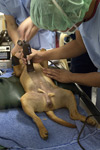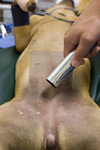The Patient
Unit 5: Preparation for Surgery
Topic 1: Hair Removal
Hair removal should be performed immediately prior to surgery and as atraumatically as possible to reduce the risk of bacterial contamination of small lacerations. Shaving removes most hair but usually results in many small wounds which has been shown to increase the post-operative infection rate up to ten-fold. Clipping is the recommended technique for hair removal. Hair should be liberally clipped around the proposed incision site immediately prior to surgery using a No. 40 clipper blade. A minimum of 15 cm on each side of the incision is recommended but this must be considered in relation to the size of the patient
General Recommendations
- Replace blunt clipper blade.
- Clean clipper blade before each use or preferably after each use.
- Use a coarser blade (No. 10) initially for dense hair coats.
- Clip initially along the hair growth pattern.
- Then clip against the pattern of hair growth for a closer clip.
- Allow time for the cutting action of the blade, avoid blades with missing teeth and apply the blade flat on the skin to reduce clipper lacerations.
- Avoid excessive heat production from continuous heavy usage to reduce clipper burns.
- Skin over irregular areas can be effectively clipped by applying tension to the skin or sliding it over to an adjacent flat area.
- Ensure edges of clipped area are straight and even for better owner acceptance, and easier drape application.
A vacuum should be used to remove hair and debris from the clipped area and adjacent table surfaces immediately after clipping.
For orthopaedic procedures on the limbs, the entire limb to the dorsal midline can be clipped. If access to the foot is not required, it is better to cover it completely with an impermeable layer such as a clean surgical glove.

 Vacuuming
Vacuuming